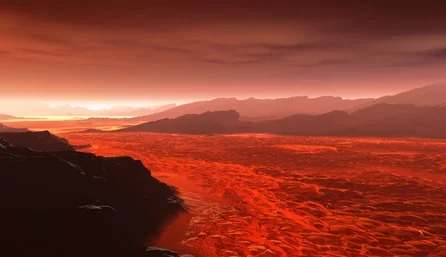Recent findings by scientists reveal two expansive and sinuous flows of lava oozing from two different corners of Venus, likely indicating that Earth’s neighbor still has active volcanoes across its terrain.
In the 1990s, NASA’s spacecraft Magellan used cloud-penetrating radar to survey most of the planet. However, back then, the relatively low-resolution images made spotting fresh molten rock a challenging task.
Today, by using modern software to peruse Magellan’s data, scientists have found two unambiguous lava flows: one oozing down the flank of Sif Mons, a broad shield volcano, and another winding its way across a western part of Niobe Planitia, a flat plain pockmarked with numerous volcanic mountains.
Considering that volcanic eruptions shift planetary atmospheres, one theory of scientists holds that, eons ago, several apocalyptic eruptions set off a runaway greenhouse effect on Venus, turning it from a temperate, waterlogged world into an arid desert of burned glass.
Strong evidence of this tumultuous volcanic environment emerged in 2023, when researchers caught sight of a volcanic vent doubling in size and possibly filling with lava in old Magellan data. Meanwhile, other scientists still yearned for signs of an unequivocal lava flow.
David Sulcanese, a doctoral student at the Università d’Annunzio in Pescara, Italy, and an author of a study reporting the discovery in the journal Nature Astronomy, granted their wish. He found bright, riverlike patches on Sif Mons and Niobe Planitia in later Magellan survey images that weren’t present in earlier data. After carefully ruling out other possibilities, including landslides, his team concluded that lava was the only reasonable explanation.
“Magellan is the gift that keeps on giving,” said Stephen Kane, a planetary astrophysicist at the University of California, Riverside, who was not involved with the new study.
According to scientists, these findings also reveal that Venus may be more similar to Earth in atmosphere than previously thought.
This result complicates the speculative detection of phosphine in Venus’s atmosphere; phosphine is a substance that is usually associated on Earth with living things. Yet, other explanations for its potential existence on Venus hasn’t been ruled out, as volcanic activity can also make phosphine. Though rebuttals to that idea have suggested that Venus simply doesn’t have sufficient volcanism to make it.
For researchers, the only way to find better answers on phosphine, Venus’s volcanic tendencies, and its cataclysmic transformation, is to revisit the planet. Luckily, a new fleet of spacecrafts are expected to do just that in the 2030s.












